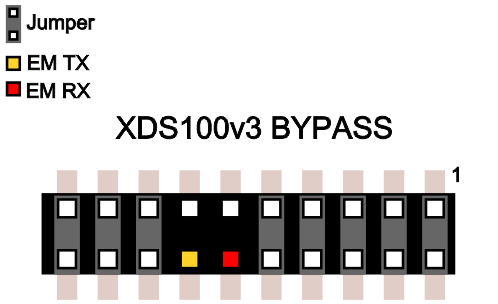SWRA466D February 2015 – August 2021 CC1310 , CC1310 , CC1352R , CC1352R , CC2538 , CC2538 , CC2620 , CC2620 , CC2630 , CC2630 , CC2640 , CC2640 , CC2640R2F , CC2640R2F , CC2640R2F-Q1 , CC2640R2F-Q1 , CC2642R , CC2642R , CC2642R-Q1 , CC2642R-Q1 , CC2650 , CC2650 , CC2650MODA , CC2650MODA , CC2652R , CC2652R , CC2652R7 , CC2652R7 , CC2652RB , CC2652RB , CC2652RSIP , CC2652RSIP
4.1.1.1 External Serial Interface
If a SmartRF06EB is being used to bypass the XDS100v3 Emulator to use an external serial interface, connect the external serial interface to the EM RX and EM TX pins on the “XDS100v3 BYPASS” header as shown in Figure 4-3.
 Figure 4-3 EM TX and RX Pins on XDS100v3 Emulator Bypass Header
Figure 4-3 EM TX and RX Pins on XDS100v3 Emulator Bypass Header